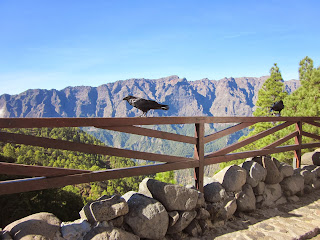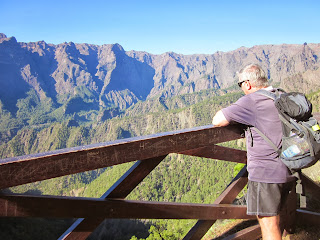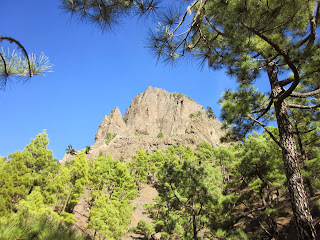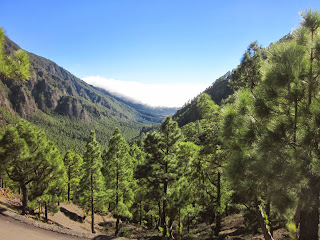As you may already know, our normal territory for walking is the north of La Palma and all things GR130 Camino Real on any part of the island. Oh and of course the GR131 which lurks some 2000m above us and which we are always promising ourselves to finish. But at times, needs must and we just have to break out and enjoy a new walk out of our usual territory. New walk for us that is.
Santa Cruz is an area where we have done relatively little walking except for a five-hour circular walk from San Pedro, a 2-hour circular walk from Mazo and the GR130 (obviously) and so it was time to reach for the La Palma Rother Walking guide to see what suggestions we might find in there. Two walks immediately sprang out at us, a walk directly from Santa Cruz to the Santuario de Las Nieves and to the Mirador Concepcion - both short at around 2.5 hours each but could be combined. We chose the Las Nieves route.

Bearing in mind that the walking guide was over 12 years old and the city bypass that we would somehow have to get the other side of has been built since the book was written, this was going to be interesting. Nonetheless, this did not explain why the route description didn't seem to fit the walk and it wasn't very long before we began to realise that whilst we might be following the signs to the Santuario de Las Nieves and the instructions of 'helpful man,' we were definitely not on Mr. Rother's route.
But for those of you who don't want to get involved in the quandary, the route is easy enough if you follow the signs - just to note that because it is a circular route, there are obviously two directions in which it can be walked.
To begin the walk then (going in either direction), start at the Naval Museum (big boat by the Plaza de Alameda).
 |
| (photo taken a previous time) |
It was after this that we immediately went wrong by crossing the bridge too early! However, it transpired that by walking it in this direction, not only was this the longer and more scenic route to Las Nieves covered in the first half leaving the shorter and less glamorous return route for later, but this is the way the signs indicate.
So ... having crossed the bridge 50m uphill from the Naval Museum to the other side of the barranco (river bed/ravine), we continued up the road with the barranco now on our left. In just two minutes, the first sign appeared which was by the corner of a house and which indicated Santuario de Las Nievas. This is where 'helpful man' keeps watch from his flat roof indicating where walkers should go. I can't of course completely guarantee he will be there when you walk the route but I feel there is a good chance.

The route from there wends uphill along stone steps and behind a staggered row of houses until five minutes later it arrives at the lovely Plaza de la Encarnacion with its benches and sturdy laurel trees all presided over by the parish church of Nuestra Señora de la Encarnación. This place of worship apparently was the first to be built in Santa Cruz de La Palma after the Spanish Conquest and the second on the entire island. If nothing else, it's probably worth a quick nip up to see it for its historical importance.
Leaving the plaza and church behind, we now set off directly from the plaza up a straight road lined with houses of every different type. Straight uphill roads are not my absolute favourite I have to admit but the houses proved interesting enough and after all, our goal of Las Nieves was only at 250m above sea level so this was just a gentle exercise rather than some madcap near vertical ascent such as on other walks.
Fifteen minutes later, we were treated to another church, or hermitage, the Ermito del Santo Cristo del Planto, founded in 1611.This was starting to turn into a 'route of the churches' which can often be the case on La Palma.
Two minutes after this church, the route takes a 90 degree right turn and onto a very pleasant wide and flat cobbled path. Time to look around - there's usually a goat down in the valley somewhere. Oh yes, we weren't disappointed.
Four minutes later, the route had done with the flat bit and we swung a 90 degree left as indicated by the sign and were heading directly uphill again. Ten minutes of walking uphill on a fairly gentle gradient, we were then thrown into a bit of a quandary when we came to a junction which offered the Santuario de las Nieves por carretera (by road) or the Camino del Dorador. Well, we didn't want to go by the road and so pondered on that idea that the Camino (path) del Dorador was probably some form of code word for Las Nieves. And in fairness, it seemed that Las Nieves hadn't been mentioned recently, only the Camino del Dorador.
But it wasn't the right way and after ten minutes we were back at the sign for Santuario de las Nieves (por carretera) and resigned to a potentially longish stretch by road. But in fact, it was only a few minutes until we came to a fairly major T-junction where we took a left and then as we rounded a bend, we could see the Santuario ahead of us.

I did wonder if this was going to be a long stretch of road where you walk and walk, never getting any nearer and Las Nieves would forever be an illusion on the hillside. This is after all the pilgrim's route and I've got a good imagination. But no, there were to be no heroics and in seven minutes we had closed right in on our goal. Interestingly (slightly), we were now at a junction where a new bypass was built about six or seven years ago because up to that point, the narrow road went right through the gap between Las Nieves church and the 'House of Pilgrims' which is opposite. An absolutely picturesque route but in reality completely impractical in terms of traffic.
However, for walkers heading up to Las Nieves, it is slightly unclear as there isn't a signpost, although there is a white over yellow blaze on the high stone wall which might suggest, and correctly so, that you turn left and walk uphill. Just two minutes later and a short cobbled path takes up to the Santuario de Las Nieves.
Now that you have arrived, you can spend a very pleasant time looking around the church, the Casa de Romeros (House of Pilgrims), the gift shop and there is also a restaurant.
The outside of the church is not particularly awe-inspiring, apart perhaps from its large size, but it's the interior which is what most people come to see. And this is after all where the statue of Nuestra Señora de las Nieves, the patron Saint of the La Palma, resides apart from once every five years when in a great procession she is brought down to Santa Cruz (The Bajada).
When it comes to the 'other' things to see and do at Las Nieves, I must admit we were slightly out of luck. The restaurant La Parilla Las Nieves was closed, it being a Thursday, but normally it is open 12.30 to 17.00hrs and then 19.00 to 23.30hrs. A return trip by car to test it out is called for!
The House of the Pilgrims was also undergoing restoration works which look as if they will continue for a month or two yet. But I'm sure that will be worth a visit when it is open again.
The souvenir shop is however open every day but you won't find anything such as traditional embroidery, cigars or even key rings with a plastic bunch of bananas. It's strictly all things religious and to do with Las Nieves. If that's what you are looking for, then you are in a very great deal of luck.
The return route along the PR-LP 2.2 begins just outside of the souvenir shop where a signpost indicates Barco de La Virgin 2.8 km away. The route at first is a slightly awkward downhill path over loose stones but after just a few minutes levels out and is a gentle amble back down to the capital. In fact, just after two minutes and you are on the flat passing an old building where goat's cheese is smoked. It's a smell that to me is quite iconic of La Palma!
After this, the route criss-crosses the stony barranco, all signed perfectly well and with little chance of going wrong or mis-interpreting the signs. Along the way, you can have fun spotting caves and a few old stone dwellings.
Thirty minutes after leaving Las Nieves, we arrived at a goat farm where the route goes right past the goat shed. We very much had the feeling that we had reached civilization - not that I have begun to mistake goats for people but more the fact that we were on a concrete road with a few houses about.
However, five minutes later we had reached the city bypass but still with 1.3km to go before reaching our start point. Wondering how we should best tackle crossing this major road, in fact it was very easy as the route takes you to the left and a slip road with zebra crossing and then a second slip road, again with zebra crossing. The traffic was so light that we didn't need cars to stop for us but at peak traffic times, I can imagine that more care is needed.
The route brought us down through the housing area of Benahoare and, on our right, the barranco with a few chickens and cockerels scratching a living. At the first bridge which crosses the barranco, there didn't seem to be any indication of where the route went, but we crossed it anyway and it turned out to correct. We also realised at this point that this was where Mr. Rother had intended us to walk. From here on in, it was downhill all the way until we reached the Naval Museum a few minutes later.
All in all, a lovely walk which is not too taxing and a good idea to combine it with lunch at the Restaurant Las Nieves. Just not on a Thursday.































